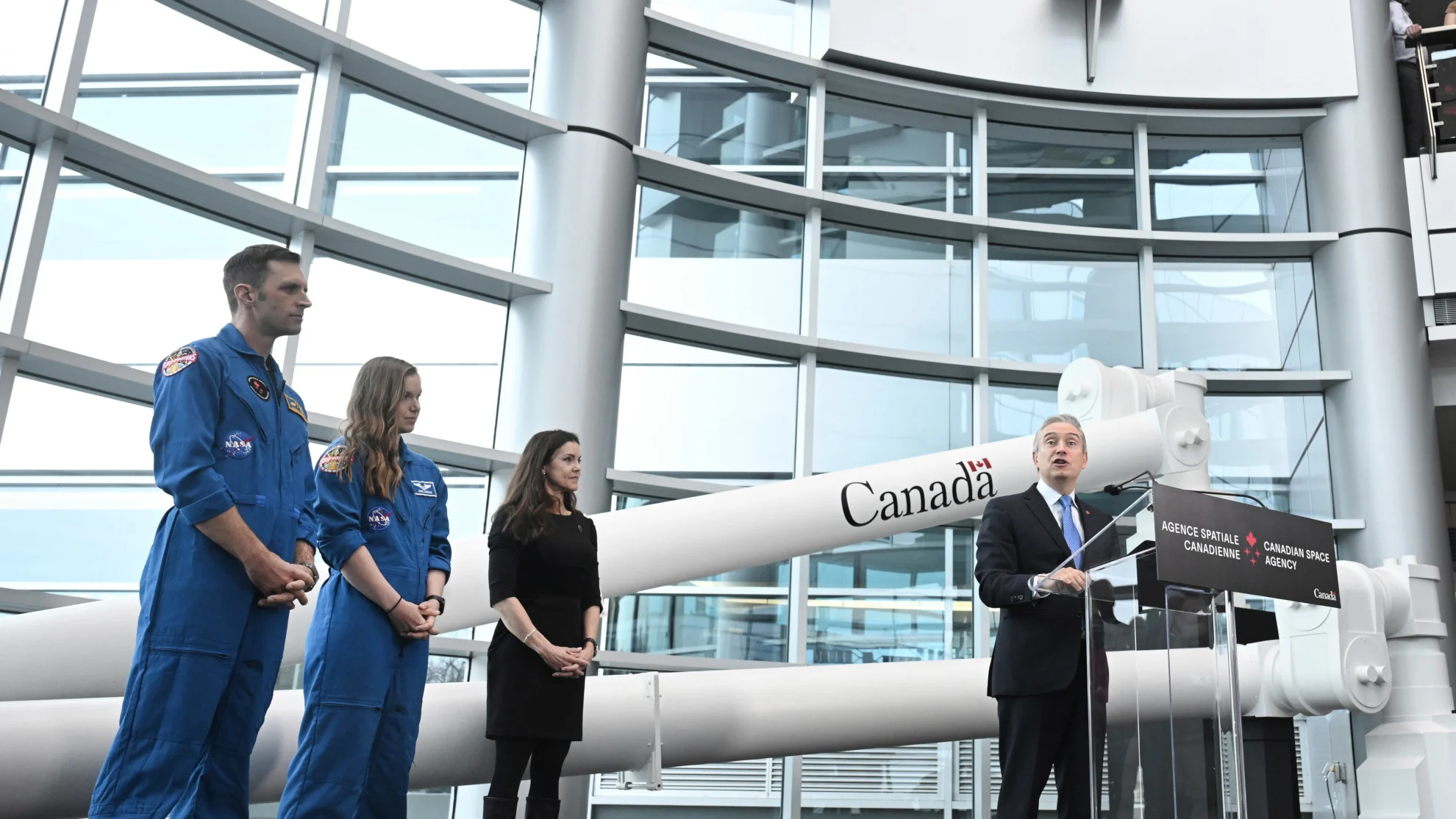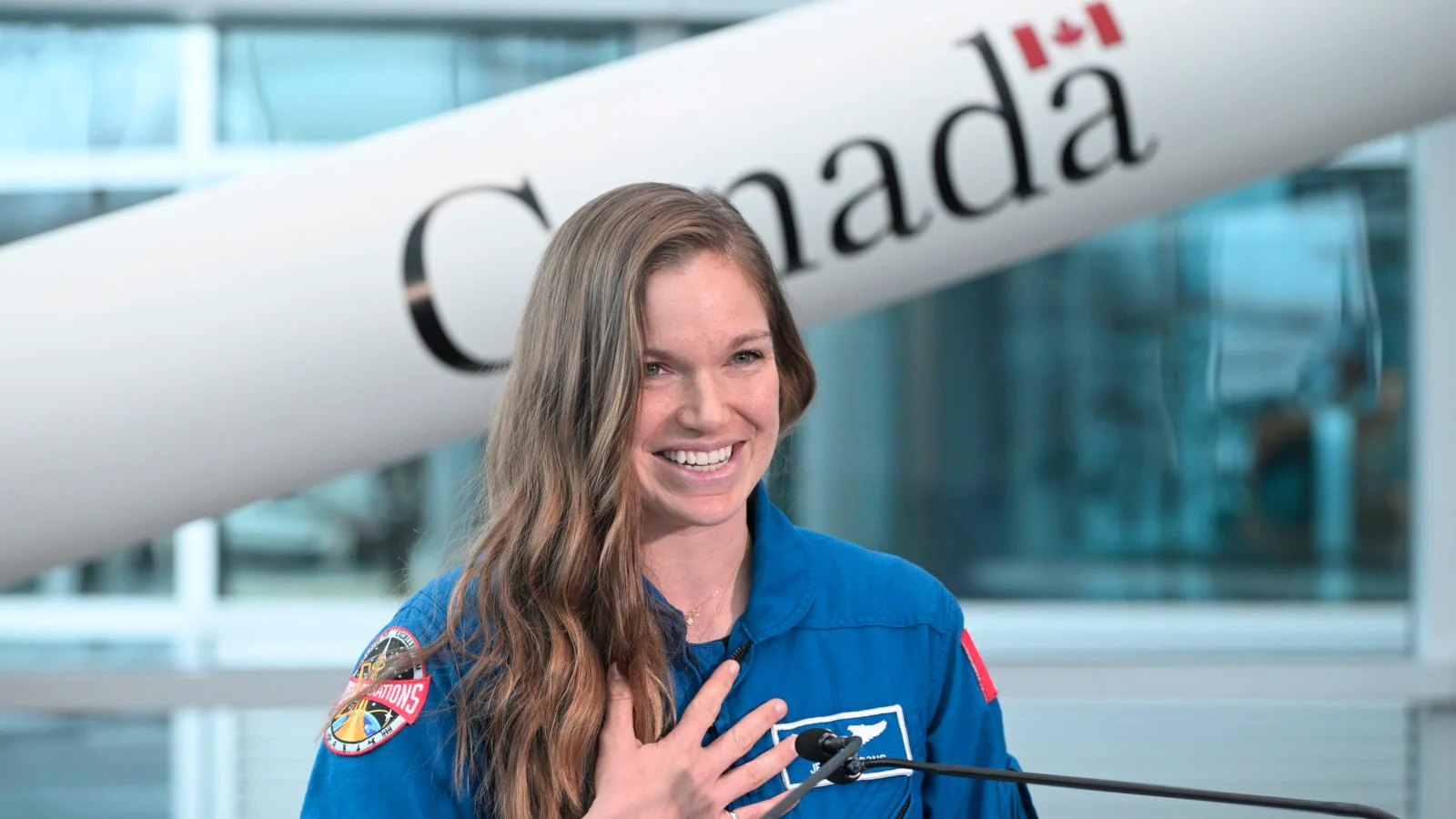
Canada's newest astronauts get their first missions to space
One will fly to the Space Station with the first operational launch of Boeing's Starliner, while the other will play a important role in upcoming missions to the Moon.
The newest members of Canada's astronaut core just received their first mission assignments, putting them on course to continue our nation's leading role in space exploration.
Wednesday, November 22, 2023 was a big day for Canadian astronauts Jenni Gibbons and Joshua Kutryk. On that day, François-Philippe Champagne, the Minister of Innovation, Science and Industry, stood in front of a gathering of CSA employees, space industry experts, academics, and press, to announce their first missions to space.

Minister Champagne poses with CSA astronauts Jenni Gibbons and Joshua Kutryk, along with CSA president Lisa Campbell, at Canadian Space Agency headquarters on November 22, 2023, following the announcement of new space missions for Gibbons and Kutryk. Credit: Canadian Space Agency
Jenni Gibbons, who was selected by the CSA in 2017, is now the official backup crew member for Jeremy Hansen on the Artemis II lunar mission.
Currently, Artemis II is scheduled to launch sometime in late 2024. Following up on the uncrewed Artemis I flight in 2022, the new mission will see four astronauts conduct a 10-day trip around the Moon and back on board an Orion spacecraft. The primary crew for the flight is filled by NASA astronauts Reid Wiseman, Christina Koch, and Victor Glover, and CSA astronaut Jeremy Hansen.
In addition, each position on a space launch traditionally has a backup crew member. There's no news yet on the backup crew for NASA's astronauts. However, if Jeremy Hansen is unable to make the flight, Gibbons will step in to take his place. This assignment guarantees that a Canadian will be flying around the Moon on Artemis II.
"For me, it's a privilege to be a support astronaut for Jeremy Hansen for the lunar mission," Gibbons said during the announcement. Listing off the various roles she will play and training she will receive, she concluded by saying: "With this experience, I'm anxious to see what awaits Canada in the future. Regardless of what it is, I will be ready."
"To all of Canada, I am so proud that space is at the heart of this nation. Thank you," she added.

CSA astronaut Jenni Gibbons speaks after the announcement of her assignment as Canadian backup astronaut for the historic Artemis II mission. Credit: Canadian Space Agency
Even though this is not a guaranteed trip to space for Gibbons, she now has an important role in the success of the Artemis program.
According to the Canadian Space Agency, "Jenni's role will be instrumental in shaping and validating astronaut training and processes for upcoming lunar missions. In other words, she will contribute to the preparation of future Artemis missions. Jenni is also training to provide support to Artemis missions from the ground as a lunar capcom — a new role for Canada."
Capcom is an abbreviation of capsule communicator, a support role for space missions — typically filled by an astronaut — who maintains communications between mission control on the ground and astronauts in space. Lunar capcoms during the Apollo missions were Americans. If Hansen makes the flight on Artemis II, Gibbons will be the first Canadian to fill the role.
Joshua Kutryk, who was also selected as a Canadian astronaut in 2017, has been assigned to the first operational flight of Boeing's CST-100 Starliner-1 spacecraft.
"I'm proud to be a crew member on this mission, but especially to be participating as a Canadian astronaut," Kutryk said during the announcement. "I'm proud that our country continues to play a leading role in space."

Canadian astronaut Joshua Kutryk addresses those gathered at CSA headquarters on November 22, 2023, following the announcement of his first flight assignment. Credit: Canadian Space Agency
Set to launch sometime in early 2025, Starliner-1 will fly to the International Space Station carrying Kutryk, Scott Tingle and Mike Fincke of NASA, as well as a fourth astronaut who has yet to be named. The crew will stay on the station for roughly six months, taking part in the numerous science experiments conducted on board and participating in station maintenance.
According to the CSA, Kutryk will be the fourth CSA astronaut to take part in a long-duration mission aboard the ISS, after Robert Thirsk in 2009, Chris Hadfield in 2012-2013, and David Saint-Jacques in 2018-2019. A long-duration mission is one that lasts longer than 90 days.
Also, while Canadian astronauts have previously flown to the ISS on space shuttles or Russian Soyuz spacecraft, Kutryk will be the first to fly under NASA's Commercial Crew Program.

This artist's rendition depicts Boeing's Starliner crewed spacecraft in orbit of Earth. Credit: Boeing
In addition to the other 'firsts' for Kutryk on this mission, as is common with astronauts on the ISS, he may also perform his very first spacewalk to install or repair equipment on the outside of the station.
(Thumbnail courtesy the Canadian Space Agency)











